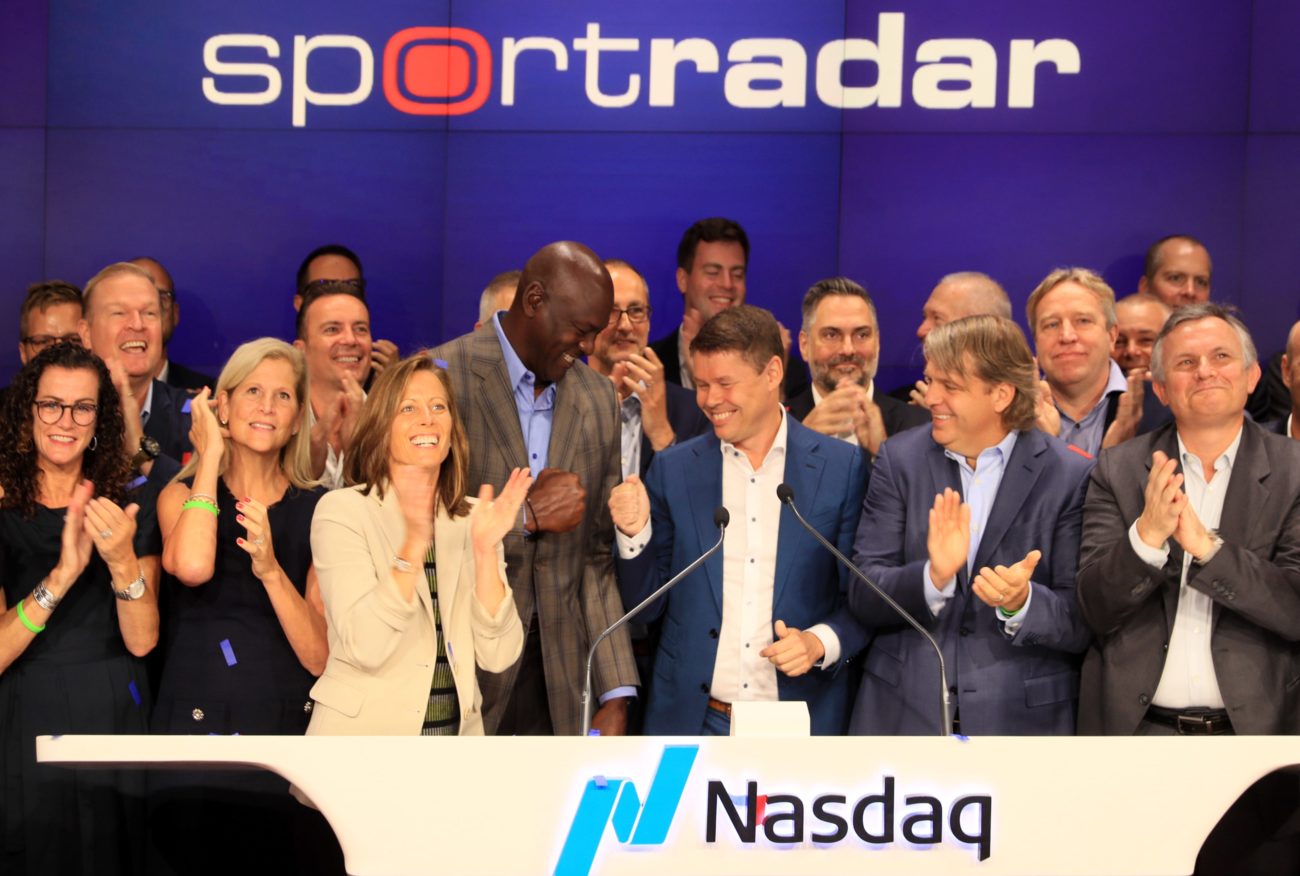Sportradar’s CEO on the factors driving growth in sports, betting and media

Sportradar’s listing on the Nasdaq Stock Exchange in September marked a key moment in its 20-year history. Whether that was transformational for the business, chief executive Carsten Koerl is not sure.
He argues that the transformational moment instead came in March 2020. When the world ground to a halt as a result of novel coronavirus (Covid-19), and sporting action was halted, Sportradar and its clients suddenly found they had no live data. “[That] is obviously necessary for a company like Sportradar to be in business,” Koerl points out.

Considering it has more than 1,600 customers in more than 120 countries, and covers more than 750,000 events each year across 83 sports, this could have been devastating. Instead, aided by the “tireless” work of its engineering team, it developed Simulated Reality in a matter of days.
This replicated the weekend’s sporting action using artificial intelligence and machine learning, to help provide operators with a source of revenue amid the shut-down.
Transformational is pulling an entirely new revenue stream out of thin air amid a global pandemic. Leading a business through a successful listing is another step forward on a strategic roadmap in Koerl’s view.
That’s not to say it was a case of going back to normal as sports restarted, Koerl adds.
“Once live sports started to return, the focus turned to other things,” he says. “What did we learn from what we just went through as a business and as a team? How do we apply it to our way of working and continue to evolve and grow?”
He views being highly innovative and forward-thinking as key cornerstones of his business, because he believes the evolution of the sports and entertainment sector demands that sort of thinking.
Fighting on three fronts
“I believe the possibilities are endless,” he explains. “We structured the company to reflect how rapidly the industry is evolving, based on three verticals.”
These core verticals comprise Sports Solutions, which provides analytics for collegiate and professional sports, betting and gaming, including systems and trading services, plus Sports Entertainment Services, which deploys technology to enhance the fan experience.
Sports Solutions was created through the acquisition of Synergy Sports, announced in March 2021. A data and video analytics specialist, it is a pioneer in the field of computer vision, to track athletes’ performance.
“[It] is changing the way sports are watched and analysed around the world,” Koerl says. “Soon we will be able to take the sporting events we already produce through this form of AI and accurately convey all the data in that match, game or event.”
For the sports betting and gaming segment, Sportradar is making “huge leaps forward” in generating more intelligence from its data to improve predictive modelling. But again, he sees scope for further enhancements, through gathering more accurate data, which in turn can be supported by Sports Solutions’ computer vision and data, to better understand the probabilities of a single outcome.
For Sports Entertainment Services, the focus is on giving fans improved access to sports, which requires a deep understanding of spectators’ needs and habits.
Koerl explains that this is coming at a crucial point, when rights holders and federations have to evolve to reflect changes in the way fans consume and engage with sports. Whether they are doing so effectively remains to be seen, he adds.
“Many have invested in digital interfaces without considering the end user – the fans. There is a significant opportunity to drive engagement beyond match centres, live scores and statistics. Where we see opportunity is in dynamic content, combining OTT with highlight clips that give the fans content they want at the moment that want to see it.”
All of this, he points out, is underpinned by Sportradar Integrity Services, which tracks leagues and competitions for signs of potential corruption. “Without integrity in sports, we as an industry will not survive,” he says. “We pioneer integrity services and products to leagues, federations and government agencies around the world because we truly believe in this cause.”
Ultimately, he sees the business as straddling two key sectors. On one side there is sports, driven by merchandising, sponsorship rights and ticketing; on the other media, comprising broadcasting, social channels and technology solutions. Betting falls between the two, and with some estimates putting market value as high as $80bn within ten years – even with the likes of India, China and Brazil not included – there is a huge potential upside.
Consolidation or deploying capital
In Koerl’s eyes, the rapid expansion of sports betting in the US and beyond, not to mention the adoption of technology across the sports and media landscape is “the tip of the iceberg”.
“As a global enterprise, we see so much potential in markets around the world,” he says. “China and India have enormous potential and we are investing in these regions. I think we’re at the beginning of this exciting journey, when it comes to seeing what sports and technology can do for fans and bettors alike.”
The sports, betting and media sectors in the US are fully aware of this opportunity, as evidenced by the flurry of team partnerships, expansive media deals – of which an ESPN tie-up remains operators’ ultimate goal – and M&A activity. This has seen a number of European brands such as William Hill and Gamesys snapped up by US peers. Entain has fended off two approaches this year alone, from DraftKings and MGM Resorts.
This could be seen as a risk for suppliers, as their total addressable market potentially shrinks. However Koerl sees market consolidation differently to others.
“[When] companies are trying to buy others in the space, to me, that is simply deploying capital,” he says. “If you can do that cleverly, you might buy a competitor. But that’s not consolidation when you look at the underlying market growth.”
Real consolidation, in his eyes, is when growth slows as markets mature and regulations tighten. In the US, states such as Texas and California are yet to open up to sports betting, meaning there is plenty of runway for the industry. “Sports betting market consolidation won’t happen for many years. We are still on a hockey-stick-like growth trajectory.”
That later-stage consolidation has happened in Europe, however. He argues that in that situation, Sportradar managed the situation well. “If you look to our turnover figures in that consolidation period, we see revenue decline,” Koerl points out. “We constantly read the market and adapt our business model.”
Rook to bishop 4
When it comes to Sportradar’s own approach to M&A, he views it as a game of chess. “I like to think a couple of moves ahead, about what happens when my opponent moves in certain ways. Sportradar’s M&A strategy in the same.”
Opportunities, he continues have to align with its long-term growth strategy. In particular solutions or businesses using artificial intelligence are key.
“Everything that helps us deploy that technology, in those verticals we are involved in – entertainment, data and betting – is a good investment,” he explains. Sports advertising also offers huge potential, particularly in the US.
The companies that could later become targets are most likely already being tracked, with Sportradar currently screening “hundreds” of companies to analyse how they could fit into its overall strategy.
That constant oversight of the market may appear to rule out more opportunistic deals, though Koerl doesn’t rule out that sort of acquisition, even if no such targets have presented themselves to date.
Equally, that chess player’s approach informs the expansion strategy. Sportradar analyses markets, in order to make early moves to prepare for market entry. This “master blueprint” strategy, Koerl explains was first used in the US. From 2014 the business was investing in sport, infrastructure and building up its capabilities to gain a first-mover advantage.
“We had the data and the analytics, and we said to ourselves that the US needed to regulate sports betting,” he says. “We did that years before everyone else. That’s the move of a chess player.”
Next on the board, he says, is India. Just as signs were pointing to sports betting being regulated in the US in 2014 – four years before the Professional and Amateur Sports Protection Act was repealed, no less – he sees similar signs.
“We are very interested in the sub-continent and we’ve been investing there for quite some time already,” he explains. “We have invested in tier one cricket rights and we will continue to do so.
“We invested in an Australian company called InteractSport which, in our view, has the best analytical solutions for cricket. We are building that stack, so we are prepared whenever a market opportunity arises, to have the ingredients to make our clients more successful.”
In the wake of a business going public, it’s almost a cliché to ask the founder how long they imagine staying in their position. But as companies mature it remains relevant, as executives start to consider whether it’s time to bow out or push on.
For Koerl, there’s simply too much still to do. “I have a clear of vision where I want to go and I believe the opportunity for Sportradar is enormous,” he says. “The moment I see this may not be working, I quickly pivot.
“I have created the perfect company for me; it unites technology and my passion for sports,” he adds. “As long as I continue to have fun doing this and as long as I feel I am contributing, I will continue to be in this business – I have such a strong passion for what I do.”
